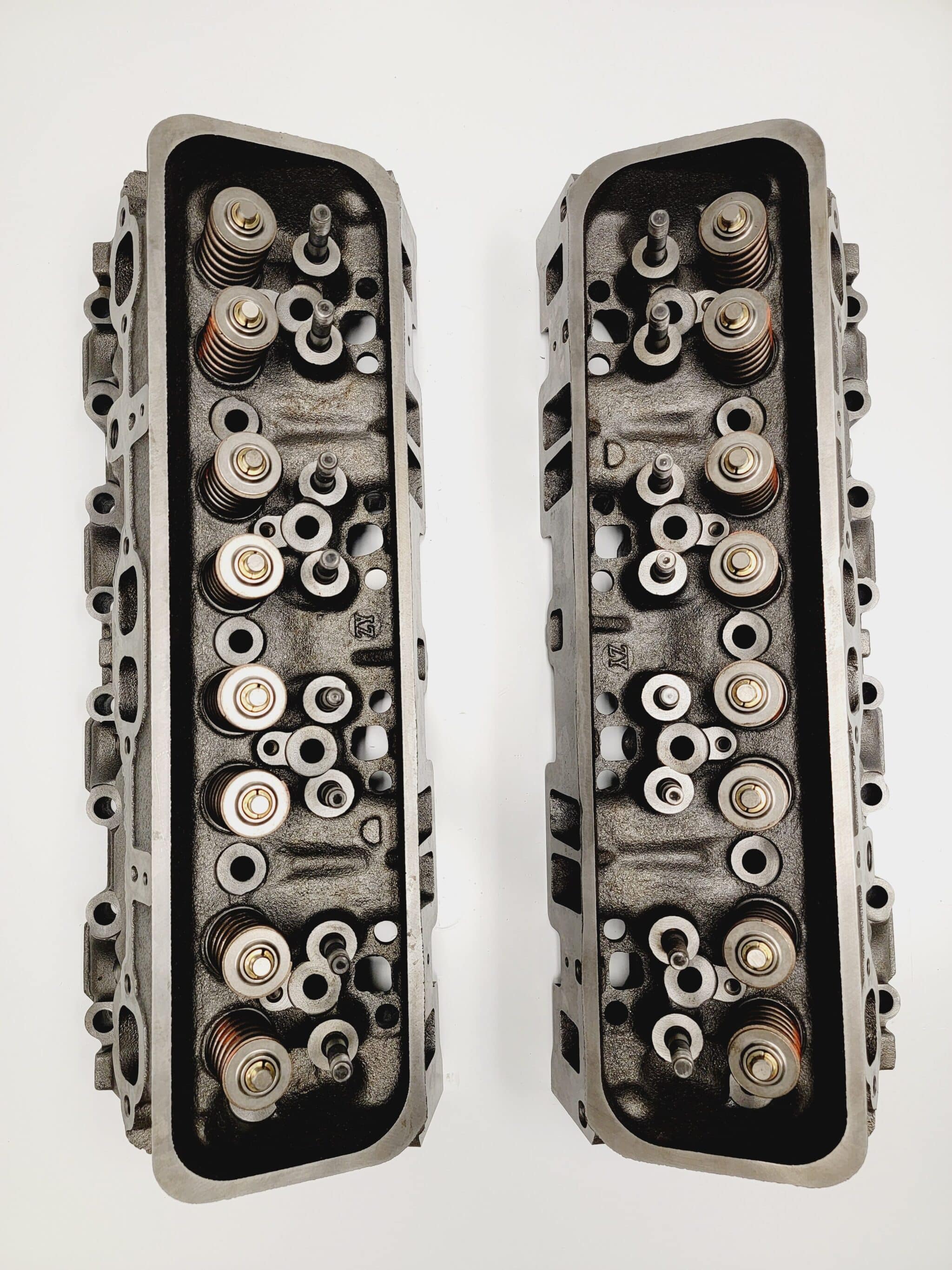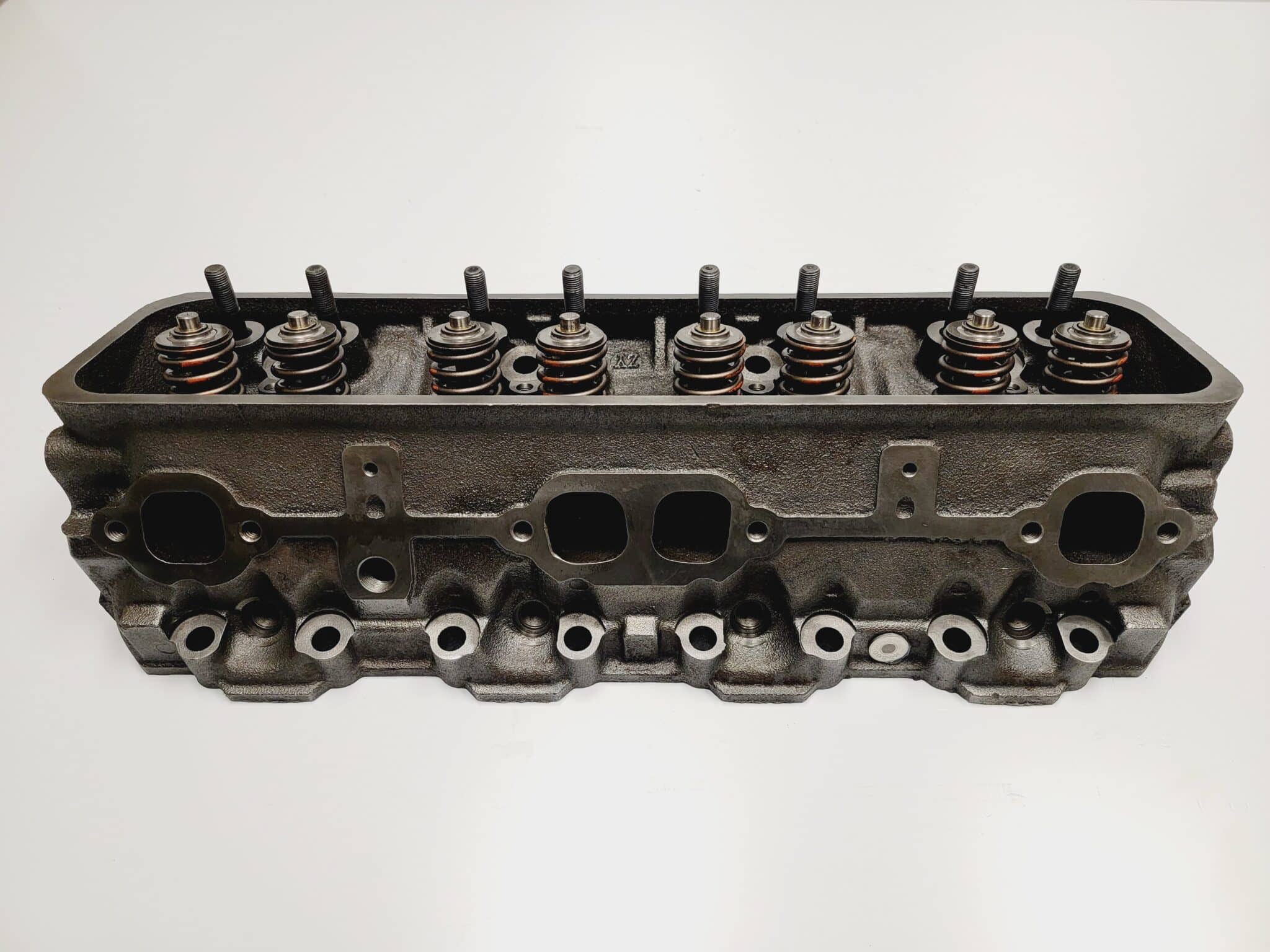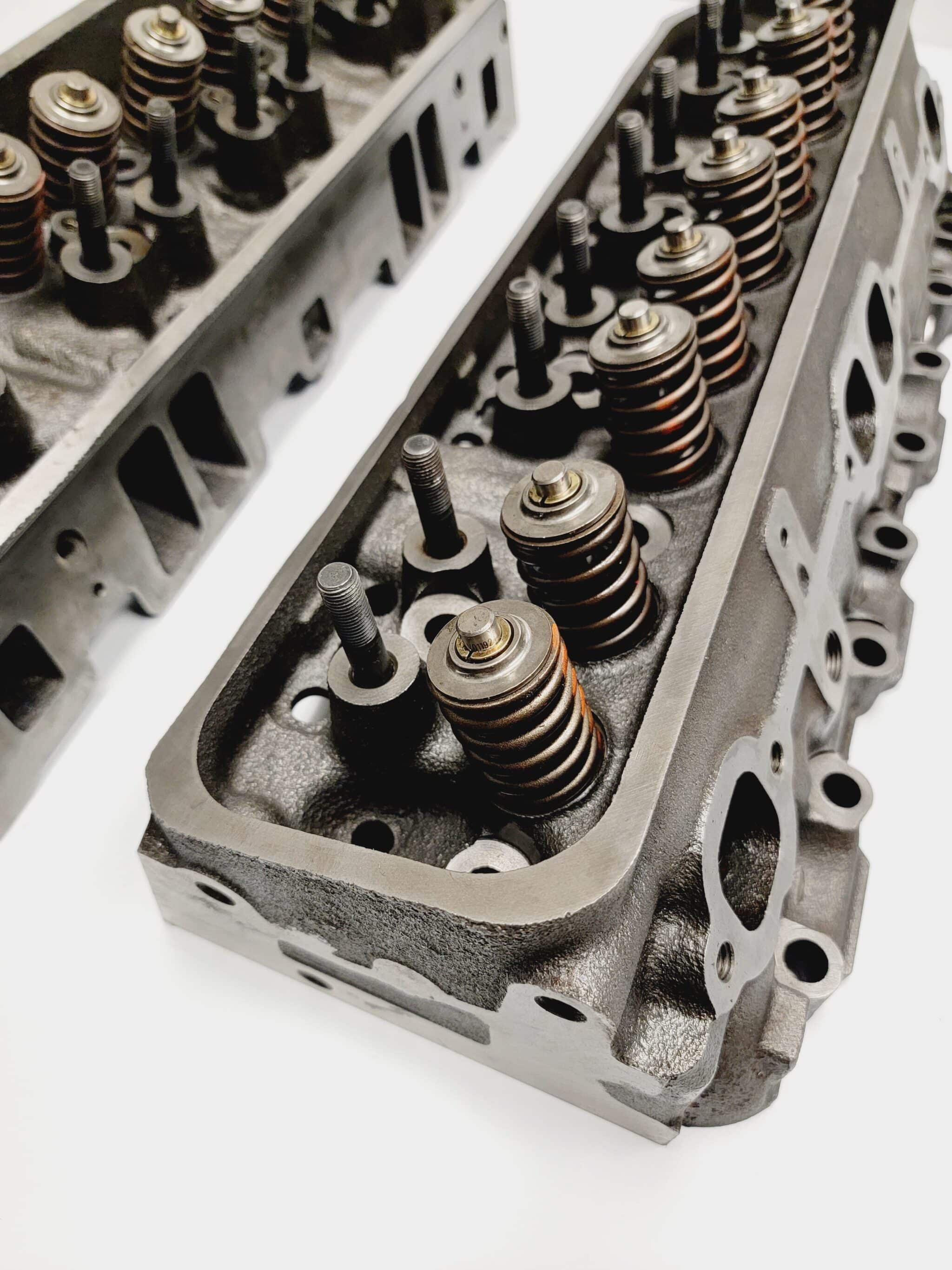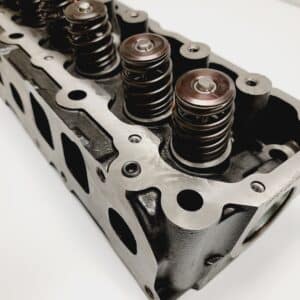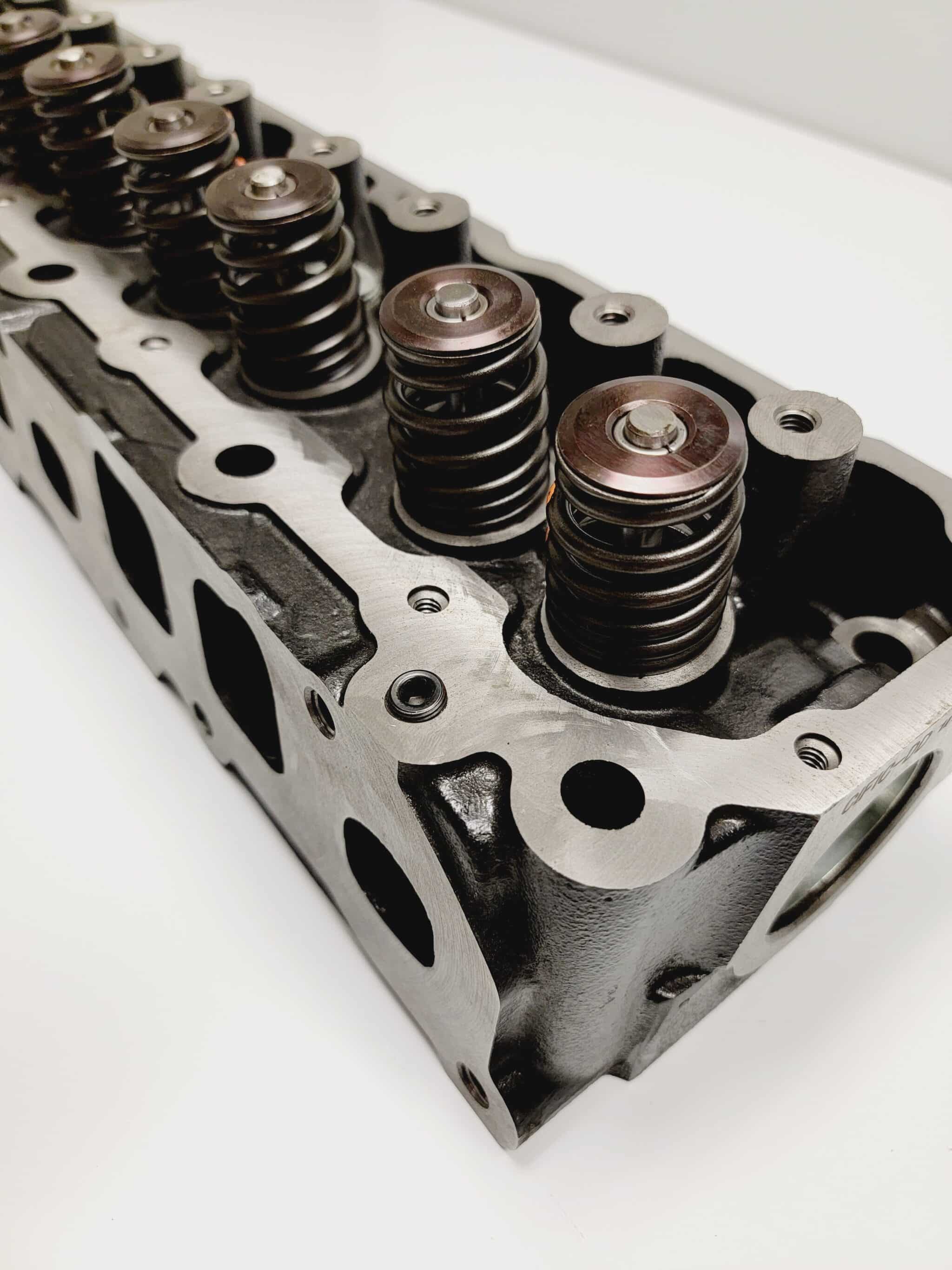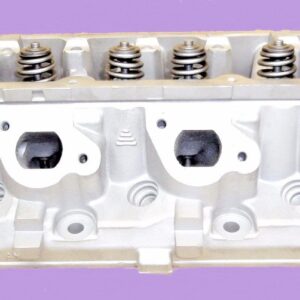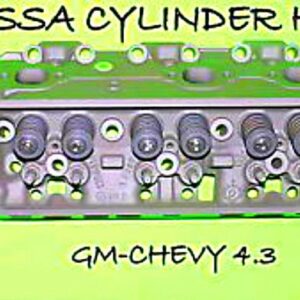Description
NEW CHEVY GM MARINE OHV 5.7 V8 350 906 062 VORTEC
NEW FITS GM CHEVY 5.7L 350 VORTEC #906/062 CAST IRON CYLINDER HEADS. THIS HEAD IS COMPLETE WITH VALVES AND SPRINGS. THESE HEADS COME WITH ALL NEW PEP BRAND STAINLESS STEEL VALVES AND SPRINGS!
130 POUNDS FOR THE PAIR.
THIS IS A AFTERMARKET HEAD AND IS MUCH THICKER AND STRONGER IN ALL THE CRITICAL AREAS. THESE HEADS ARE SOLD AS A PAIR.
THIS HEAD FITS YEARS 1996 TO 2002 BUT PLEASE CHECK YOUR HEAD TO MAKE SURE IT IS THE SAME.
VEHICLES & YEARS PPLICABLE:
CHECK OUT THE HISTORY OF THE VORTEC ENGINE: https://en.wikipedia.org/wiki/Chevrolet_small-block_engine_(first-_and_second-generation)
CHECK OUT OUR OTHER CHEVY LISTINGS: https://www.cylinder-heads.com/product-category/chevy/
CHEVROLET 1500 PICKUP 1996-1999
CHEVROLET 2500 PICKUP 1996-1999
CHEVROLET VAN 1996 -2002
ESCALADE 1999-2000
GMC 1500 PICKUP 1996-1999
GMC 2500 PICKUP 1996-1999
GMC VAN 1996-2002
SUBURBAN 1500 1996-1999
TAHOE 1996-2000
YUKON 1996-2000
NO CORE RETURN REQUIRED.
PLEASE INCLUDE YOUR AREA CODE AND TELEPHONE NUMBER
A cylinder head is an essential component of an internal combustion engine. It sits atop the engine block and forms the top of the combustion chamber. It contains the intake and exhaust valves, spark plugs, and fuel injectors, all of which play critical roles in the engine’s operation. During the engine’s operation, the cylinder head seals the top of the combustion chamber to contain the extreme pressures and temperatures generated during the combustion process. The intake valves allow the air-fuel mixture to enter the combustion chamber, while the exhaust valves allow the burned gases to exit. The spark plugs ignite the air-fuel mixture, initiating the combustion process. The fuel injectors ensure that the correct amount of fuel is delivered to the combustion chamber. Overall, the cylinder head is responsible for controlling the flow of air and fuel into the combustion chamber and the evacuation of exhaust gases, ultimately contributing to the engine’s performance and efficiency.
Marine cylinder heads typically have to withstand harsher conditions such as saltwater exposure, so stainless steel valves or Inconel valves which are more resistant to corrosion compared to regular car and truck cylinder heads. Stainless steel valves are used in cylinder heads because of their resistance to corrosion, high temperatures, and wear. This material also retains its strength at high temperatures, making it a durable and reliable choice for engine components that are constantly exposed to heat and pressure. Additionally, stainless steel valves offer better performance and longevity compared to other materials, making them a popular choice for applications where reliability and durability are essential.
Clearwater Cylinder Head, Inc. thoroughly cleans, inspects, and pressure tests all our cylinder heads. All seat and guide work is performed as needed on the lastest state of the art Serdi or Sunnen seat and guide machine. The head then moves on to a Rottlier CBN resurfacing machine where it is cut to the required RMA finish. We then install a quality valve seal and pull a vacuum on each valve to insure there is a perfect seal between the valve and the seat. All machine work performed on the latest state of the art equipment. Head is complete and ready for installation.
WE ARE A HUGE CYLINDER HEAD SHOP WITH THOUSANDS OF HEADS IN STOCK. WE DEAL WITH ALL MAKE AND MODEL CYLINDER HEADS. IF YOU DO NOT SEE THE CYLINDER HEAD YOU NEED PLEASE CONTACT US 1-800-572-1963.
HAVE A RARE OR HARD TO FIND CYLINDER HEAD? LET US REBUILD YOUR CYLINDER HEAD FOR YOU.
Hours of operation Monday – Friday 8 AM to 5 PM EST
SHIPPING RATE APPLIES TO CONTINENTAL UNITED STATES ONLY. ALASKA, HAWAII, GUAM, VIRGIN ISLANDS, AND PUERTO RICO PLEASE E-MAIL OR CALL FOR SHIPPING RATES
SHIPPING INFORMATION: We ship worldwide.
Insurance, packaging, and handling are all included in the shipping price.
International Bidders, when inquiring about shipping fees please include city, country AND POSTAL CODE.
YOUR OLD CYLINDER HEAD:
We have no up-front core charge and we give you 30 days to return the core.
We make it easy for you to return your core as we provide you with a prepaid UPS peel and stick return shipping label located with the invoice on the outside of the box behind the plastic. Just put your core head in the box that you received your new/rebuilt head in and attach the prepaid peel and stick label. You may then give the box to any UPS driver you may see, or take the box to any UPS pickup point. We will accept your old cylinder head no matter what is wrong with it as long as it includes all the parts that the new head came with. You will never be charged extra because your old head is damaged. Cracked head? OK! Bent valves? NO PROBLEM! Head taken apart? UNDERSTANDABLE! (as long as you put all of the parts in the box). We have no up-front core charge.
WARRANTY INFORMATION: Clearwater Cylinder Head, Inc. provides a TWO (2) year unlimited mileage warranty. A copy of the warranty card will be enclosed with your invoice.
Clearwater Cylinder Head, Inc.
5100 Ulmerton Road #2
Clearwater, FL 33760 USA
Clearwater Cylinder Head, Inc. is dedicated to quality craftsmanship and is pleased to offer this warranty. We invite you to read this entire document carefully prior to installing your cylinder head.
Please do not hesitate to contact us should you have any questions.
1) Acceptance of this head constitutes acceptance of this warranty.
2) Heat tab must be in place on head, not altered or melted.
3) Any claim must be returned to Clearwater Cylinder Head, Inc. for inspection. A copy of invoice must accompany head. A Return Authorization number must be obtained.
4) Only 1 (one) warranty per purchase.
5) Warranty begins at the date of purchase.
6) No incidental, consequential, punitive or over the road damages.
N O L A B O R
WARRANTY COVERS:
Parts Warranty only – All original cylinder heads must be returned for warranty.
WARRANTY DOES NOT COVER:
1) Damage caused by improper installation, accidental over heating, abuse or neglect.
2) Loss of time, use of vehicle, phone calls, inconvenience or consequential charges.
3) Fluids, tow charges, rentals or diagnosis.
4) Repairs made without prior authorization will void all warranties.
5) No warranty on Commercial, Industrial Racing/ Pro stock or Marine Use
If you are not in the United States and you want a shipping quote please include your country and postal/zip code when inquiring.
Replacing a marine cylinder head is a delicate and important task that requires specialized knowledge and skills to ensure the engine operates smoothly and efficiently. It is recommended to consult a professional marine mechanic or technician who has experience working with marine engines to properly diagnose the issue and perform the replacement, as any mistakes in the process could cause further damage to the engine or compromise its performance on the water. Regular maintenance and inspections can also help prevent the need for major replacement work in the future. Replacing a marine cylinder head is a crucial task, as the cylinder head plays a vital role in the engine’s combustion process. It is important to consider factors such as the engine model, make, and specifications when selecting a replacement cylinder head. Additionally, proper alignment, torque settings, and gasket installation are essential to ensure a secure and leak-free fit. Given the complexity and precision required, seeking assistance from a qualified marine mechanic or technician with expertise in marine engines is strongly recommended. Additionally, routine maintenance and inspections can help identify any issues early on and prevent the need for major replacements in the future.
A marine engine, like other internal combustion engines, operates by converting fuel and air into mechanical energy through a series of controlled explosions in the combustion chambers. In a typical four-stroke marine engine cycle, air is drawn into the combustion chamber as the piston moves downward on the intake stroke, then the intake valve closes and the piston moves back up to compress the air in the compression stroke. The fuel is injected or mixed with the air at this point, and the compressed air-fuel mixture is ignited by a spark plug in gasoline engines or by compression in diesel engines, resulting in an explosion that drives the piston down in the power stroke. Finally, the exhaust valve opens, and the piston pushes the burned gases out on the exhaust stroke before the cycle repeats. This continuous process generates the power needed to propel the boat through the water. Regular maintenance, proper fuel and oil levels, and good operating practices are essential to keeping a marine engine functioning properly and efficiently.
Common problems that marine engines may encounter include issues with cooling systems, fuel delivery, electrical components, and mechanical wear and tear. Cooling system problems, such as clogged raw water intake filters or malfunctioning impellers, can lead to overheating and engine damage. Fuel delivery issues, like dirty filters or water contamination, can cause rough idling or stalling. Electrical problems, such as corroded connections or faulty sensors, may result in starting difficulties or erratic engine performance. Mechanical wear from lack of maintenance or incorrect operation can lead to issues like piston scuffing, valve damage, or bearing failure. Regular maintenance, proper inspection, and prompt addressing of any issues can help prevent these problems and keep the marine engine running smoothly.
Marine engine gaskets are essential components that create a seal between engine parts to prevent fluid or gas leaks and maintain proper compression in the engine cylinders. These gaskets are typically made of materials like graphite, rubber, or metal, depending on the specific application and engine requirements. Common types of marine engine gaskets include head gaskets, exhaust gaskets, intake manifold gaskets, and oil pan gaskets. Proper installation and maintenance of gaskets are crucial for the smooth operation and longevity of a marine engine, as any gasket failure can lead to significant engine damage or performance issues. Regular inspection, replacement when necessary, and using quality gaskets designed for marine applications are important practices to ensure the reliability and efficiency of a marine engine.
The lifespan of a marine engine can vary depending on several factors, including the engine type, manufacturer, maintenance schedule, operating conditions, and usage. Generally, well-maintained marine engines can last anywhere from 1,500 to 3,000 hours or more before requiring a major overhaul or replacement. Proper care and routine maintenance, such as regular oil changes, checking fluid levels, monitoring engine temperature, and following manufacturer guidelines, can help extend the life of a marine engine. It’s also important to avoid overloading the engine, operating at excessive speeds for prolonged periods, or neglecting maintenance tasks, as these can contribute to premature wear and shorten the engine’s overall lifespan.
A turbocharged marine engine is equipped with a turbocharger, which is a forced induction device that increases the engine’s power output by compressing the incoming air to produce more oxygen for combustion. The turbocharger consists of a turbine and a compressor linked by a shaft. As the engine’s exhaust gases pass through the turbine, it spins the turbine wheel, which is connected to the compressor wheel. The compressor wheel forces air into the engine’s intake manifold at a higher pressure, resulting in increased power and efficiency. Turbocharged marine engines are commonly used in larger vessels to improve performance and fuel efficiency while maintaining a compact size and weight. Proper maintenance, monitoring boost levels, and ensuring sufficient cooling are essential for the reliable operation of turbocharged marine engines.
How to Know If You Need a New Cylinder Head?
Every engine is due for repairs from time to time. Among the most important pieces of most engines is the cylinder head, which, if damaged, can prove increasingly perilous the longer it goes unrepaired. Here are some warning signs and symptoms which may be caused by cylinder head damage.
Weak Engine
Cylinder heads are responsible for containing and directing the internal combustion of an engine’s cylinders, meaning if that ability is hindered, the engine’s efficiency and power may take a hit. This can be seen in lower gas mileage, sluggish acceleration, and difficulty getting up steep inclines.
The Verdict: This is most often among the first signs of a cracked cylinder head, and usually can be repaired if caught in its early stage.
Oil Leakage
Oil is responsible for lubricating the engine’s mechanical parts, including the cylinder head. A cracked cylinder head can cause this to leak, which can be most noticed by a puddle of oil forming on the ground when the vehicle is parked for a long enough time. Such a sign can be a cause for concern, as oil or coolant may also back up into the engine’s internal chambers if the crack is large enough.
The Verdict: Usually, unless oil has backed up into the engine and caused any damage to other parts, a leaking cylinder head can still be repaired and may not require replacement.
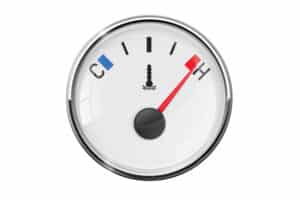 Coolant Leakage
Coolant Leakage
Coolant is responsible for cooling the engine, cylinder head, and many other processes. Similarly to oil, a cracked cylinder head can cause coolant to leak. This can be noticed by either a puddle forming beneath the car when parked or an overheating warning lighting up on the vehicle’s dashboard. Coolant can potentially contaminate the oil, and therefore the cylinder head should be repaired as soon as possible.
The Verdict: Unless the coolant has contaminated the oil due to a large enough crack in the cylinder head, at this stage the head can usually be repaired, not replaced.
Engine Misfires
Within an engine’s cylinders, air and gas form a pressurized mixture which explodes upon ignition, creating power. A cracked cylinder head may be unable to create the required atmosphere for proper combustion within those cylinders, leading to failures to combust, or engine misfires. The engine may die repeatedly during use, or fail to start at all.
The Verdict: This is a more severe sign, and usually is indicative of serious damage. It’s always better to take a cylinder head in for repairs or replacement if it starts to show signs of wear, to avoid even higher repair bills when the cylinder head’s failure leads to damages elsewhere in the vehicle.
Smoke
White smoke coming from the engine can indicate a catastrophic failure of the cylinder head, in which exhaust gases are vented directly into the engine space. This is the last stage of total cylinder head failure, and should be avoided by simply going in for repairs at the first signs of damage.
The Verdict: A cylinder head at this stage must be replaced as soon as possible, as it’s either venting exhaust gases or causing coolant to contaminate the oil, neither of which are healthy for any vehicle’s systems.
The Cylinder Head Repair Experts
Since repairing bad cylinder heads or gaskets is not a typical DIY project, we recommend that you consult a professional company. Clearwater Cylinder Head Inc. (CCH) is a reputable, experienced (over 25 years) dealer. We specialize in providing quality and warranty-backed rebuilt cylinder heads for a variety of vehicles (cars, trucks, boats, etc). With a massive online catalog of cylinder heads, we most likely have the cylinder heads for your repair needs. The knowledgeable staff at CCH is happy to help you find the cylinder head that is right for your vehicle. Please contact Clearwater Cylinder Head Inc. toll-free at 1-800-572-1963.
The cylinder head is one of the most vital parts to your car’s mechanics; your gas-powered car could not work without it. The cylinder head and head gasket sit atop the engine block over the cylinders. The head covers and protects the engine components and creates the correct vacuum for the engine to work. The cylinder head works along with the camshaft, induction and exhaust systems to process the fuel, air, and exhaust to provide your car’s horsepower. Damage, such as, leaks or cracks, in your cylinder head can cause monumental damage to your engine. The correct shape, size, quality, and use of your cylinder head can make all the difference in how your car runs and can help avoid costly engine repairs. To choose the best cylinder head for your specific needs follow these tips for “5 Things to Check Before Buying a Cylinder Head” when choosing a rebuilt, remanufactured, or new cylinder head…
- Choose a Compatible Head – Only choose from cylinder heads designed for your car’s specific make, model, year, engine size, and engine enhancements (turbo, supercharger, etc.). Choose a cylinder head metal (aluminum or cast iron) that is compatible with what your engine block is made of as the metals contract and expand at different rates; mismatched cylinder heads are prone to cracking. Choose a cylinder head with right hardware (bolts) for the engine block to ensure your head will fit correctly.
- Consider Intake and Exhaust Port Volumes – Bigger intake port volumes are not always necessarily better; depending on engine size and/or application, smaller intake ports may be more suitable. Smaller intake ports often provide better performance for street application as they produce more low-end torque and crisper throttle response, while larger intake ports are more beneficial for larger or higher-revving engines as they allow for more air flow. Choose a good-flowing exhaust port that is the correct size, by comparing to stock exhaust port volume and valve size for your specific engine.
- Determine the Combustion Chamber Size and Design needed for Your Engine – Choose a combustion chamber size that raises the compression ratio to maximize your engines efficiency, while matching the components of your specific engine, such as, bore, stroke, head gasket, and piston shape, as well as, deck clearance and ring location.
- Consider Application – Whether you are using your car for street or off-road driving or drag, circle track, or road racing, deciding the primary application for your engine is important is picking out the cylinder head to best fit your needs. Valve lift, air flow, and duration can be altered to provide the best performance for your car’s specific application.
- Buy from a Reputable Dealer – Choose cylinder heads from a reputable dealer! Clearwater Cylinder Head Inc. (CCH) is dedicated to providing customers with quality cylinder heads backed by their warranty. The knowledgeable associates at CCH would be happy to help you in choosing the cylinder head that is right for your specific needs. Contact Clearwater Cylinder Head Inc. toll free at 1-800-572-1963 or by email at cchcylheads@aol.com.
NEW CHEVY GM MARINE OHV 5.7 V8 350 906 062 VORTEC

